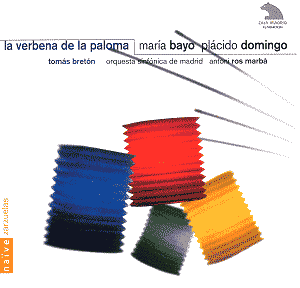A verbena is a popular Madrid festival,
with dancing and fair attractions, drinks and food. All the verbenas
are related to a religious festival, so the title of this piece
refers to that of the Paloma, an image of the Virgin of Solitude.
But this is not a religious work, it is one of the best know zarzuelas
by the Spanish composer Tomas Breton. Breton composed many other
works (and other zarzuelas) but it is with this work that his
name is most often associated.
‘La Verbena de la Paloma’ is a zarzuela of the
type known as genero chico, a one act comedy which could
contain as much or as little music as was necessary. Some of these
one act comedies had virtually no music, or just one musical piece
which could be omitted if the theatre had no orchestra. The more
complicated ones are effectively short comic operas, and this
is the case here where ‘La Verbena de la Paloma’ (one of the most
complicated works in this genre) contains 12 substantial musical
numbers. It is also full of the most curious characters. Where
else do you get a typesetter hero and a randy, elderly chemist?
The action of the opera takes place on the night
of the Virgin of the Paloma, August the 14th. Julian
is a young typesetter who works in a printing house. He is in
love with Susana, but very jealous which makes Susana suffer so
she decides to get back at him. Susana lives with her sister Casta
and their aunt, Antonia (an unpleasant woman). The nearby chemist,
Don Hilarion is a randy old man who protects the two sisters (and
flirts with them). Next to the chemists is the tavern whose owner
is married to Rita, Julian’s godmother who advises him to leave
Susana. Julian is always complaining and he threatens to make
a scene if his jealousy of Susana is found to be justified.
As can be seen, there is quite a large cast for
such a small opera. Breton makes a great virtue of this feature
and there are very few real solos. All the action takes places
in the context of the neighbourhood and solos develop into ensembles
or have activity in the background. This gives the music a real
ensemble feel and it needs a good ensemble cast to bring it off.
Here, the opera is sung by a group of Spanish singers who sound
as if they have been singing Zarzuela all their life, and they
probably have. They work well as a company and the two leads,
played by Placido Domingo (singing what sounds like a baritone
role) and Maria Bayo, slot into it well and provide good ensemble
performances without any starry bad manners. The opera is presented
without dialogue. In principle, I prefer operettas performed with
their dialogue. But given my complete lack of Spanish, I was moderately
happy just to be listening to Breton’s fascinating score.
The opera opens with the prelude, a lively pot-pourri
of tunes from the main numbers in the work. It is given an infectious
performance by the Orquesta Sinfonic de Madrid. This is followed
by a striking extended scene which is a tri-partite ensemble using
three different groups of people (Don Hilarion and his cronies,
Julian and Rita, the tavern Landlord and his customers). This
is followed by Julian’s romance, ardently sung by Domingo. He
sounds a little understated, perhaps due to the baritonal register
of the part or perhaps just from care not to over-dominate. Even
here, the other groups on stage comment and form an attractive
background.
In a solo for Don Hilarion, about his love for
women. Rafael Castejon as Don Hilarion has a voice that is now
possibly more buffo than bass, but this hardly matters in his
wonderfully idiomatic performance.
The next number introduces further interesting
strands to the ensemble as a singer inside the Melilla Café
sings to piano accompaniment. Milagros Martin gives a throatily
effective performance of the song and then gradually other characters
take up the tune and it develops into a lively ensemble.
There follows a pause, a nocturne for the Night
Watchman and two guards. Enrique Baquerizo is highly effective
in the half sung, half spoken parlando of the Night Watchman.
In a lively scene for Don Hilarion and the two
sisters. Maria Bayo as Susana sparkles beautifully and gives shapely
but sparky performance. Now a mazurka (on violin and piano) comes
from the café. As with the earlier café scene, the
cast dance to the music and gradually take it over. Julian and
Rita’s duet is crisp with tension but this duet gradually develops
into dialogue and ensemble.
The next number, which is a quintet, is a highly
effective and sophisticated piece. Don Hilarion sings with the
two sisters (Susana and Casta) but their lighthearted song is
interrupted periodically by Julian and Rita. The composer here
is responsive to the needs of the drama and as Don Hilarion has
his path blocked by Julian (who wants to accompany Susana himself),
so Hilarion’s joyful song stops suddenly.
The final scene is a long, concerted Habanera
during which Breton brilliantly manipulates his musical material
and the attendant drama. As on the rest of this recording, the
cast make a fine ensemble and give a sparkling account of this
lovely finale.
This is a highly recommendable recording. It
naturally recommends itself to lovers of zarzuela but also makes
an ideal introduction to those who are new to the genre.
Robert Hugill
